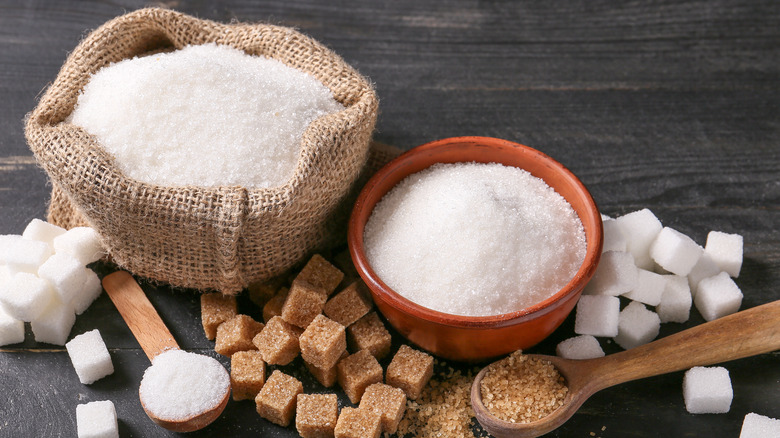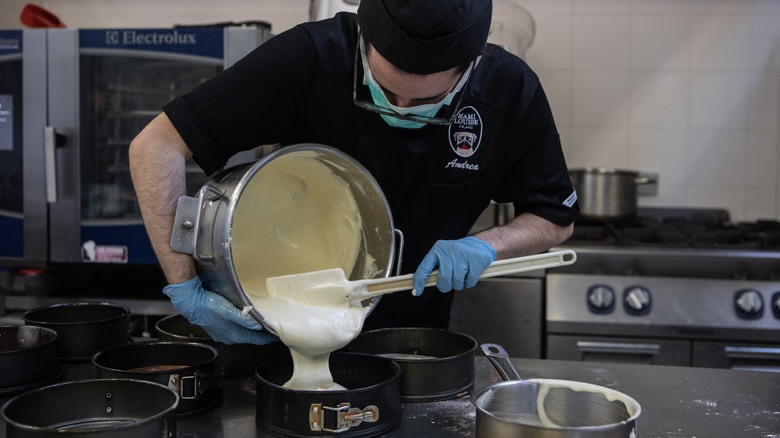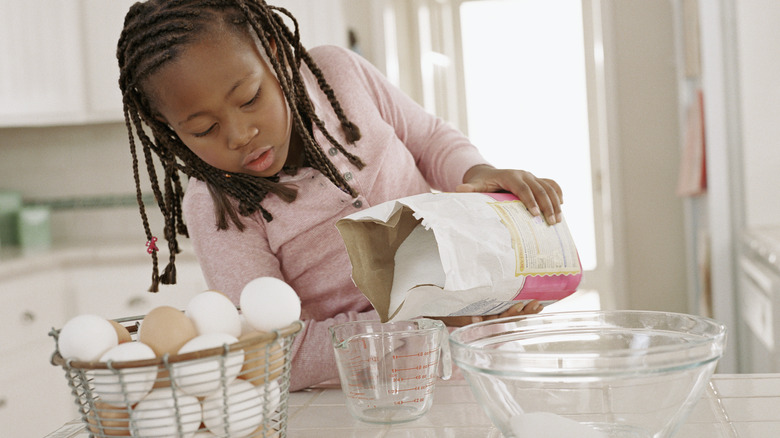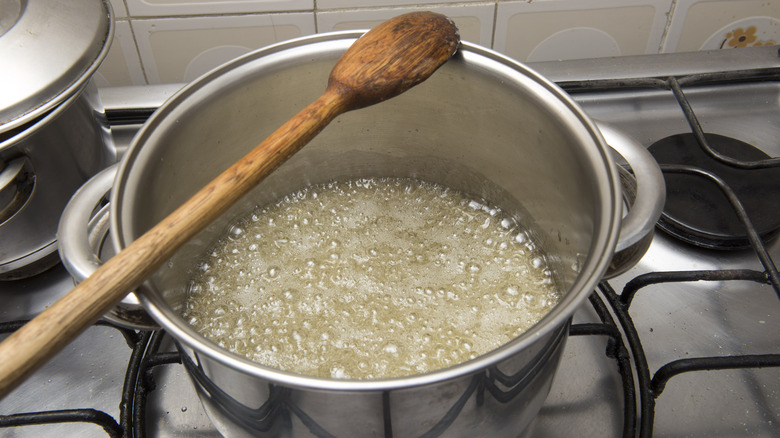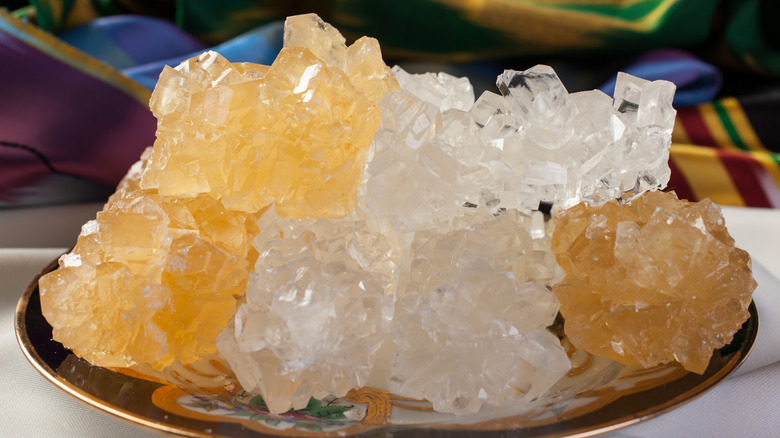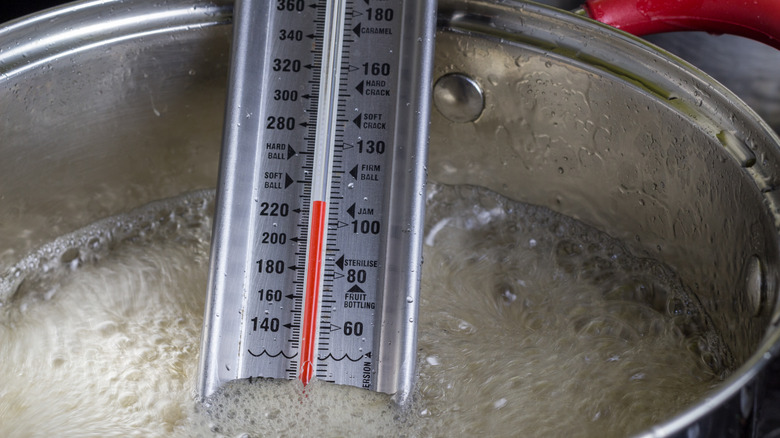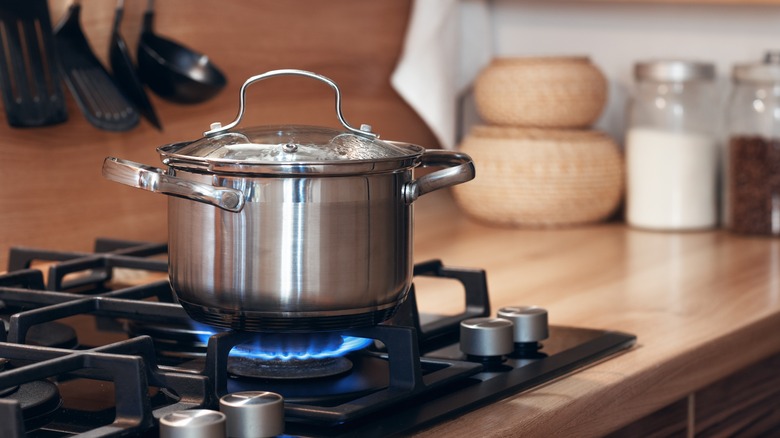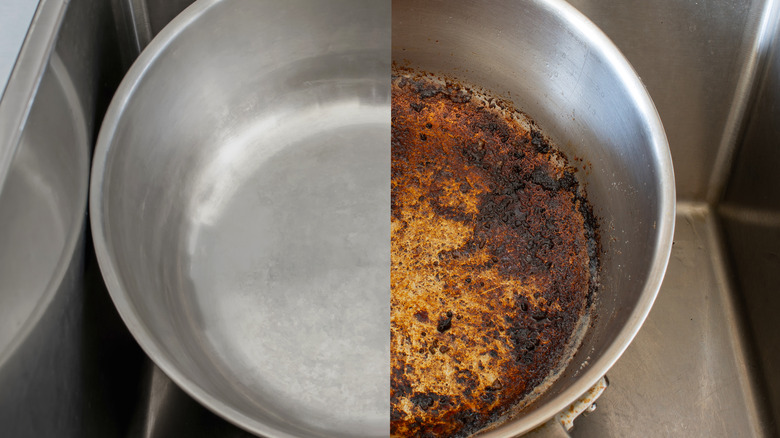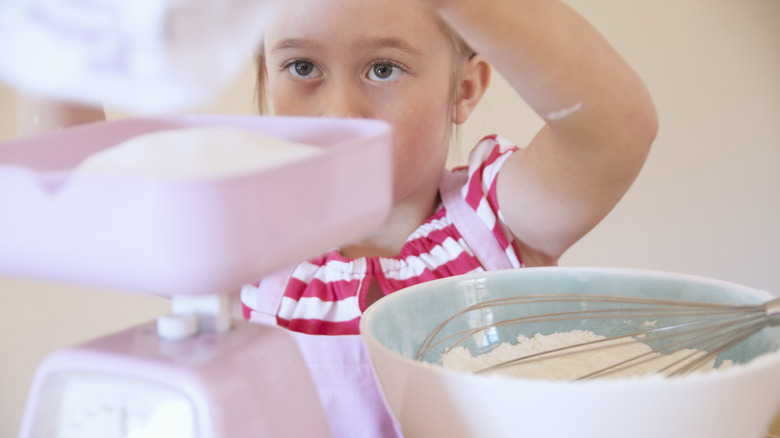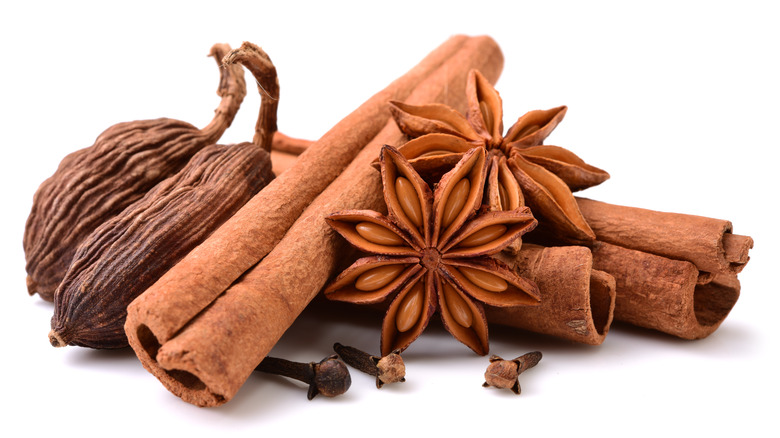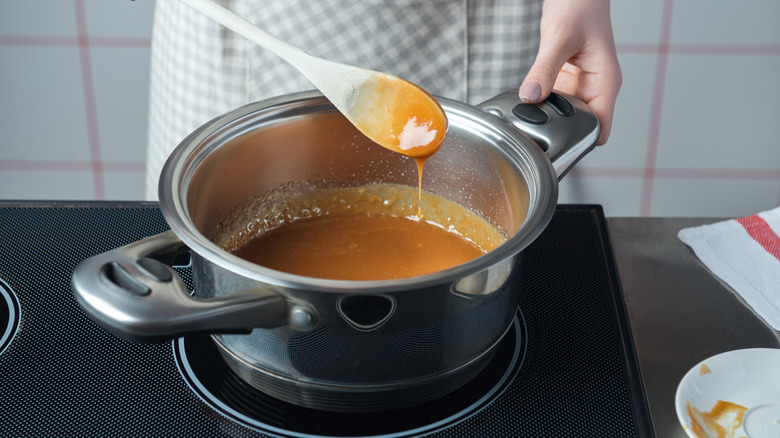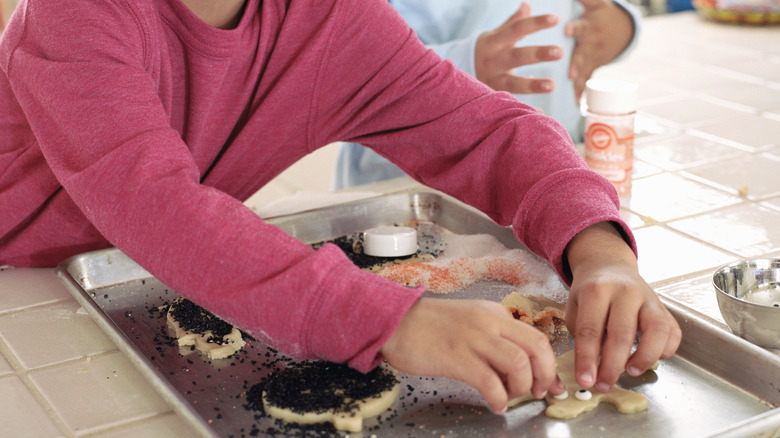11 Tips When Cooking With Granulated Sugar
Whether soothing the heart after a devastating breakup or celebrating another completed rotation around the sun, sugar has a way of making everything just a little bit better. From baked cakes and cookies to rock candy and even adding a hint to tomato sauce to dilute the acidity, sugar (in moderation, of course) can do just about anything.
Granulated sugar is robust and is a jack-of-all-trades kind of sugar. It's neutral in taste, so it doesn't alter the actual flavor of your goodies, and it is generally easy to use. But, sometimes, some issues can arise if you're not careful. Maybe it starts to clump up randomly in its bag, or it's suddenly burning unexpectedly whenever cooking with the sugar on a new stovetop. When cooking with sugar you don't expect it to throw you a curveball, so what in the world are you supposed to do when it does?
To help make sure you squeeze every bit of delicious goodness out of that bag of white table sugar, here are tips and tricks to help maximize the sugary punch of your next baking extravaganza.
Store sugar correctly
That bag of sugar you bought from the grocery store can last a long time. Like, a really, really long time. You're not going to pop open the bag to find wiggly worms like the last batch of flour you purchased a few months ago, and it's not going to go stale or lose its taste.
With that said, if you're not careful, you could end up with clumpy sugar or even a bag of sugar that somehow converted into a brick. This happens when sugar is exposed to moisture. Moisture leaches onto the sugar and, just as was the case when you ate cotton candy and licked your fingers as a kid, that moist sugar will stick to everything!
And because there's nothing but sugar trapped in that bag, the moisture will begin pulling the sugar together into clumps, and the longer moisture is present, the harder and tougher those clumps become.
Instead of hacking away at that clump bag of sugar as if you were working in some kind of coal mine, all you need to do is properly store your sugar. Pour the sugar out of the bag once it's opened into an air-tight container, and keep it in a cool, dry location. If you use it often and prefer to keep the container on your countertop, just make sure the container is solid (such as stainless steel), in order to block out sunlight.
Keep the heat low
Burning your sugar does open up a world of potential. It can give you deeper, often more intense flavors. Caramel, syrups, and other sweetened goodies that come from this overcooking of sugar can be fantastic. But how do you make sure you avoid burning sugar and steer clear of overcooking the granulated sugar? When it comes to this, the name of the game is keeping your temperature low.
Sure, that might sound obvious, but it's as simple as that. You want to keep your stovetop temperature on low when working with sugar. It is incredibly important to have patience whenever working with sugar. Trying to take shortcuts or speed up the process will only lead to less-than-desirable results. Just enjoy the sugar cooking process and work at a slow temperature.
Have you found that you're following the timing instructions for a particular baked good or sugar treat and, for whatever reason, it always ends up burnt? It's likely because the sugar within what you're cooking or baking is burning. Turn the temperature down for the next batch, and you'll have much better results (always have an internal oven temperature you can read because oftentimes, the actual internal temperature does not match what the gauge indicates).
Combine sugar with water before setting on heat
When a recipe requires mixing sugar with water and heating the water up, you might assume it's best to warm the water before adding the sugar. This, however, is not the case. Sugar is like the hands of little kids, and it wants to touch everything. So if you add the sugar to water that is already on heat, the sugar will try to cling to the spoon or any other object you use to mix the sugar into the heated water (if water is boiling and a colder spoon is inserted into the water, the sugar within the water will naturally try to stick to it). The cooler the water temperature, the less likely this is to happen.
Now, this doesn't mean you need to start with ice-cold water or anything like that. But to avoid losing some of your sugar because it's sticking to stirring utensils, combine it with the water before setting it on heat.
Sugar will still dissolve into the water when it is at a colder temperature, so doing so at room temperature will work fine. And you won't lose any unnecessary sugar during the mixing process.
Consider wetting your sugar first
Decided to try your hand at making caramels? Fantastic! There's truly nothing like homemade caramels, especially during the holidays! There are a few tricks to master when first breaking into the world of homemade caramels, one of which is controlling the sugar on the stovetop before it goes from caramel to overcooked and burnt.
Because the cooking temperature is higher with caramels, you won't have as much time to work with the sugar before it moves from granulated white sugar to caramel to scorched and ruined. We, however, are here to show you how you can buy yourself a bit more time on the stove so you can hopefully avoid the burning issue.
To do this, add a small amount of water to the sugar. You don't need much water. Just a few drops to help moisten the sugar and help prime it for dissolving. The few drops of water will already begin to break down the sugar. This way, it will dissolve faster into whatever liquid you have on the stove. When the water dissolves faster, you'll have more time to work with the sugar on the stove, which in turn makes it easier to remove the sugar from the stovetop before it burns (which doesn't take long after the sugar begins to smoke).
Add an interfering agent if crystallization is a problem
When you work with sugar, have you noticed the formation of crystals along the side of your pot or along other areas of the cooking surface? This is because sugar crystals, as we mentioned earlier, will stick to anything, and if there is a rough patch on the pot or even a screw that connects to the pan's handle, it can cause sugar to begin collecting and eventually begin to develop crystals.
Unlike those second grade science projects you performed where you grew sugar crystals on popsicle sticks, crystallization is not something you want when dealing with baked goods. If crystals continue to form no matter what you do, you'll need to add an interfering agent. This can be a squirt of lemon juice or a dab of vinegar, and either will break up the crystals and prevent crystals from forming during the cooking process. As long as you use less than a teaspoon or so of the interfering agent, you shouldn't taste it.
Invest in a candy thermometer
In many candy recipes, there are very specific temperatures you need to reach throughout the process. These temperature readings will tell you if the sugar has likely dissolved or when the temp is right to begin adding additional ingredients. So instead of guessing at the temperature, you need to be sure, and the best way to do this is with a thermometer.
Theoretically, you can use a stainless steel meat thermometer in a pinch, but we prefer not to use items typically jabbed in the back side of a turkey or roasting chicken. Instead, we like to grab our candy thermometer. These thermometers are great because they are easy to place against the sides of pots, and the design makes them much easier to use with your cooking sugar. Plus, there are times when you'll be working with bubbling, boiling water, or smoking caramel sugar that might be spraying more particles into the air than Mount Vesuvius. Do you really want to jab your hand through all this for a temperature reading? Probably not. With a candy thermometer, you don't have to.
Your pot size matters
When it comes to working with sugar on the stovetop, the size of the pot absolutely matters. This is especially true if you're making any kind of syrup (regardless if it is for cocktails or for baked goods). The sugar and water mixture should fill up the pot about halfway. If the pot is too small and the water level is above this, you run the risk of the water boiling over (and cleaning dried sugar water off of a stove after it has become hard and sticky is not fun cleanup).
On the other end of the spectrum, if the pot is too large, it will take forever to cook (remember, you can't turn the heat up as you'll risk burning the sugar). And the longer it takes to cook the sugar, the greater the risk of overcooking it. So, don't just grab any random pot and run with it. Pick out the right-sized pot and avoid possible headaches later on.
Make sure to use a clean pot
It might sound like an obvious statement, but how often have you moved from one baked good to another and just decided to use the same pot or cooking utensils? After all, you might just be making a second batch, and all the ingredients are the same, so what could it hurt? In the case of sugar, it could be hindering the entire recipe.
It is very important for you to accept cleaning a second pot and bring in a new one instead of using a dirty one. The formation of crystals when you're cooking with sugar is one of the biggest problems you'll face. And as we've learned over the years, there are so many culprits that lead to crystals, whether it's leaving a spoon in the pot, a screw from the pot handle, or a scuff mark in the pot. All of these objects and textures may lead to the formation of crystals. The same is true if there are crumbs or debris from a dirty pot. Protect your recipe from crystals, and only use clean dishes whenever working with sugar.
Cut back, don't cut out
We fully applaud your desire to remove sugar from your diet and go with something lower-calorie. We don't always have the willpower to do that. However, don't cut it out completely. There are so many textures you simply can't replicate by replacing sugar with an alternative. However, instead of using a sugar substitute, consider just cutting the amount of sugar down instead of cutting it out. Using a substitute will not only alter the flavor of the baked good or treat, but it will also completely alter the final texture.
Unless you're following a specific recipe that details you exactly how much to remove (and what to replace it with) begin by removing about 25% of the sugar. You might find this is the most amount of sugar you can remove while maintaining its texture and still remaining somewhat sweet. Or, you might find it's possible to remove more sugar for your next batch. In that case, remove one-third of the sugar and then perhaps even half of the sugar. Keep pushing the sugar reduction until you find that "sweet" spot of just enough sugar to maintain its texture and deliciousness and not enough sugar to heavily impact your dietary goals.
Warming spices can increase sweetness
You know those cartoons where a little devil appears on a character's shoulder, telling them to do bad things, and then a little angel appears on the other shoulder, telling them to be good? That's basically what happens to us when thinking about adding more sugar to a recipe. Boy, do we want to sometimes, but then that little angel appears and tells us to behave.
Well, what if we told you it's possible to increase sweetness without adding another spoonful of sugar? It's true. All you need to do is keep some warming spices on hand. There is a handful of warming spices to choose from, although cinnamon, nutmeg, cloves, and allspice are some of the most common.
These are popular holiday spices added to baked goods to help sweeten them up without actually adding more sugar to them (because the last thing we need during the holidays is more sugar on top of the mountain of sugar cookies we likely ate the day before). You can take advantage of this little holiday technique and add some warming spices to your current baked goods. Sure, it will give what you're making a slightly new taste, but you might be surprised just how amazing one of these spices is and how it can upgrade your baked good. So whether you're trying to cut down on sugar or just avoid adding more to your recipe, reach for the warming spices instead.
Don't stir while boiling
Chances are if you've ever made any recipe requiring you to boil water with sugar in it, you returned to the roiling, boiling water and gave it a few quick stirs. After all, that's what you would do with just about any other recipe, so why not do it with sugar, right?
Well, we're here to tell you to stop. Sugar is not going to settle on the bottom of the bowl. It will dissolve into the water with or without you stirring it (in fact, if you listened to our earlier suggestion, you should have combined the sugar and water before heating it up anyway).
Inserting any kind of stirring utensil into the boiling water is going to have two adverse effects on whatever you're making. First, the colder spoon is going to affect the temperature of the water. Second, and most harmful to your recipe, sugar that is in the water will stick to the spoon, and every time you remove the spoon or other cooking utensil, you'll be removing sugar from the water (it also might increase the chance of crystallization happening with sugar on the spoon).
On top of all that, you're just giving yourself more work. Don't work harder; work smarter. And in this case, smarter is not stirring the boiling sugar water. It, unlike most things in life, will take care of itself.
Don't remove sugar if you want a crispy texture
Replacing sugar with a substitute is a great way to cut down on calories, and it's also beneficial for a number of other health concerns. However, in terms of baked goods, replacing sugar can prove, at best, problematic and, at worst, a complete disaster.
If you've attempted to swap out sugar for something else, you probably have discovered your cookies or other sweetened goodies are lacking the crispy, subtle crunch it once had. This is 100% because of the lack of sugar, and the real problem is you can't just head to the grocery store and try out a different sugar substitute for better results. No other non-sugar substitute is going to give you the crispy texture because sugar helps baked goods spread during baking, which in turn helps the baked goods gain that desired crispiness.
So what does this mean? Are you stuck eating lifeless, overly squishy cookies for the rest of the time because you want to swap out sugar? Not necessarily. Instead of completely removing the sugar, you should consider blending sugar with your artificial sweetener or sugar substitute of choice. This way, you'll still knock off some of the sugar calories, and you'll still be able to enjoy a lower-calorie treat without sacrificing texture.
You might want to whip up a few test batches before presenting your final mixture to family and friends. Try a 50/50 split of sugar/sugar substitute, then increase or decrease.

